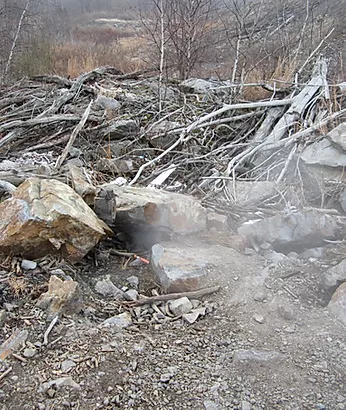Centralia

Investigating microbiome resilience as an underground fire burns
Centralia, Pennsylvania, is the site of an underground coalmine fire that has been burning since 1962. It currently underlies more than 150 acres and continues to spread slowly (3-7 m/yr) through underground coal seams. Heat, steam and combustion products (CO, CO2, SOx and NOx) vent upward from the fire through the overlying soils. The surface soil temperatures can exceed 80°C, scarring the landscape with dead vegetation that reveals the fire's subsurface trajectory. As vented gasses pass through the overlying rock and soil, soil temperatures increase while soil chemical composition is altered by spontaneous and microbially-mediated chemical reactions. As the fire expands into new areas, it also retreats from some affected sites, which can then recover.
This unusual habitat provides a unique opportunity to investigate the impact of an extreme, long-term (press) thermal disturbance on soil microbial communities. It also offers an opportunity to understand the selective pressures and community processes that drive the prevalence and maintenance of thermophiles (Chlorflexi, Firmicutes and Armatimonadetes) that are typically rare in temperate soils but have become prevalent in these fire-affected soils. Chloroflexi and Firmicutes are of particular interest for natural product discovery. These thermophiles likely play key roles in modulating the sensitivity and recovery of Centralia soil communities to the fire conditions. Furthermore, the interactions between thermophiles and other microorganisms may change as temperature increases, and it is likely that these interactions impact community stability.
We use the Centralia ecosystem as a model to understand how diverse soil microbial communities respond to an extreme and unnatural disturbance. We hope that by understanding the mechanisms of how complex communities respond to this worst-case-scenario fire stress, we can understand the capacity of similar systems to respond to and recovery from disturbance more generally.
Dr. Tobin and her team of undergraduate researchers in the Department of Biology at Susquehanna University are our enthusiastic collaborators for this research.
This work is supported by the National Science Foundation CAREER award and Michigan State University. We thank the Pennsylvania Department of Environmental Protection for site access.



 Print
Print Email
Email